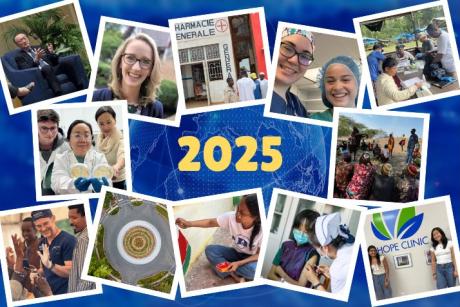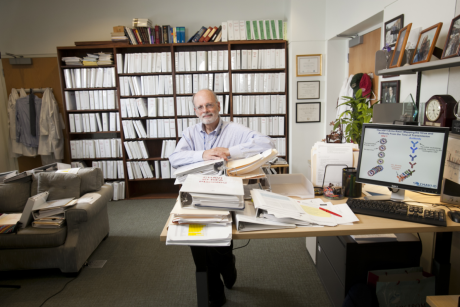
Dr. Julian Hertz, assistant professor of surgery and global health at Duke, and DGHI graduate.
Published September 9, 2020, last updated on September 10, 2020 under Research News
Duke Global Health Institute recently interviewed Julian Hertz, assistant professor of surgery and global health at Duke. Hertz is an emergency physician who also spends time researching the underdiagnosis of heart attacks in Sub-Saharan Africa, and is especially interested in the heart health of people with HIV. His current work focuses on developing interventions to improve cardiovascular emergency care in northern Tanzania.
Hertz earned his Master of Science in Global Health at Duke and participated in the Global Health Pathway for Residents and Fellows program administered by the Duke Hubert-Yeargan Center for Global Health, a part of DGHI.
Where did you attend college and did you study global health as an undergraduate?
I did my undergrad degree at Princeton where I was a chemistry major.
So then how did you first get interested in the field of global health?
After college, I spent a year volunteering at a clinic in rural Haiti. I fell in love with medicine and global health there. I still go there all the time and I’m still involved in the clinic that I first worked at. We’re out in kind of a rural area.
Did you go right to med school after that?
Yes, after my time in Haiti, I came to Duke as a medical student and while I was at Duke, I did a Fogarty International Scholarship, which is an NIH-sponsored scholarship. I worked with John Crump, who is a DGHI faculty member, doing research in Tanzania.
How did you balance your research in Tanzania and medical school?
I took two years off of medical school and lived in Tanzania and had an amazing time. I learned a ton about research and fell in love with the country and learned Swahili. I stayed with a host family who kind of became my adopted family. It was a great two years.
What did you study in Tanzania?
I did research mostly related to fever, especially mosquito-borne illnesses.
When you came back to Duke and finished up medical school, did you know what type of medicine you wanted to practice?
After medical school, in 2016, I went to Vanderbilt University School of Medicine and did my residency in emergency medicine. Then, after spending a year on the faculty here at Duke, I decided to do the global health pathway, a fellowship in global health research. My primary mentors were John Bartlett, Nathan Thielman, Jerry Bloomfield, and Janet Prvu Bettger, all of whom are DGHI faculty who do a lot of cardiovascular research.
I went on to get a master’s degree at DGHI and then I went back to Tanzania this time as a Fogarty fellow and I spent 2018 to 2019 doing cardiovascular disease research there. My interest in the project was really spurred by my time in Tanzania as a medical student. Even though I was doing infectious disease research, I noticed there was a lot of diabetes, high blood pressure — the same kind of conditions we see in the U.S.
In a video filmed in Tanzania, Dr....
What is it about heart disease that captured your interest and made you want to study it further?
There’s growing data that in Sub-Saharan Africa there’s an increasing burden of cardiovascular disease. Working in Haiti and Tanzania, anecdotally I didn’t see anyone diagnosed with a heart attack. The purpose of the project was to try and understand why there were so few heart attacks in Tanzania relative to the [high] risk factor burden — the burden of uncontrolled high blood pressure we see in the emergency department in Tanzania is similar to the burden seen in the U.S., but the number of heart attacks were much less. I was very interested in that.
How did you go about studying this discrepancy you saw?
We did a number of things in our study. We observed in the emergency department in Moshi, and we observed care for patients who presented with chest pain or shortness of breath. Less than 2% were tested for heart attacks. We tried to understand why so few patients were tested for heart attacks and did qualitative questions with doctors in the ED there, and they described a lot of barriers related to diagnosis and care of heart attacks.
We went into the community and asked people if they knew any symptoms of a heart attack and only about 3% could identify chest pain as a symptom of a heart attack. Francis Sakita is the head of the Department of Emergency Medicine at Kilimanjaro Christian Medical Centre, in Moshi, Tanzania, and was just so helpful and was a wonderful partner for our study.
What did you learn from your initial research?
After the first part of the study was completed, it basically showed there were a lot of people presenting with chest pain and patients didn’t know what the symptoms were and doctors didn’t test for heart attacks. It left us questioning how many heart attacks were out there.
Basically, after those findings, we began testing every patient who presented with heart attack symptoms to the ED. They received an EKG (electrocardiogram) and a blood test that checks the biomarker for a heart attack (troponin) and we found that about 22% of those patients were having a heart attack.
This was way more than the 1.8% who were diagnosed prior, in the first part of our study. It suggested that heart attacks were extremely common and about 90 percent were being missed. And it also raised the possibility that there was a large undetected burden of disease among those not even coming to the hospital?
How did it compare with U.S. stats?
In the U.S., only about 5% of patients who present to the emergency department for chest pain have a heart attack, so there was a relatively high burden at this emergency department in Tanzania. We also found that about 43% of patients who presented to the emergency department in Tanzania died within 30 days of presentation – which is heartbreaking and also alarming. It’s an astoundingly high mortality rate and certainly the highest that’s been reported anywhere in the world for decades. In the U.S., the death rate 30 days after a heart attack is less than 10%.
This suggests that the burden of disease is unrecognized, underdiagnosed and undertreated. And that was the conclusion of my fellowship project.
Research-wise, where do you go from here?
The first thing I’m doing is a study for CFAR – the Center for AIDS Research. It looks specifically at heart attacks among patients who are HIV-infected. HIV is a risk factor for heart attacks and the largest burden of HIV in the world is in Sub-Saharan Africa. It’s possible these patients have an extremely large unrecognized burden of heart attack.
So what we’re doing is enrolling patients with HIV and looking for evidence of prior heart attacks on their EKGs. And looking at what kind of barriers to care they experience. And do they know they have high blood pressure, and are they on the right medications?
How feasible is your research now with the pandemic happening?
Tanzania is currently allowing approved research studies to re-start, including ours. So we’re trying to maximize use of questionnaires via telephone, and we will maximize PPE to minimize exposure in-person.
So that’s the first part of the study – trying to understand the burden of heart attacks in patients with HIV. I’ve applied for a K23 grant from the National Heart, Lung, and Blood Institute to get implementation training to conduct and implement a study to improve heart attack care and outcomes in Tanzania.
Beyond this next study, what does your future in global health hold?
Emergency medicine is my passion. I think my experiences in Tanzania have given me a lot of perspective on medical culture and doctor culture. This is not a problem unique to us in the U.S. or to doctors and patients in Tanzania. There’s this gap between data and science and medicine that implementation science is meant to bridge.
It takes a long time before medical education and medical culture catches up to the epidemiology and evidence. But medical culture is such an important part of how patients are diagnosed and treated.
In emergency medicine, we’re at the very front lines of care for everyone who walks in the door and there’s this new heightened sense of risk. I want to improve emergency care for cardiovascular diseases in Tanzania and I hope that we can, with our partners there, develop interventions and solutions that can be adapted to other low-income settings.


